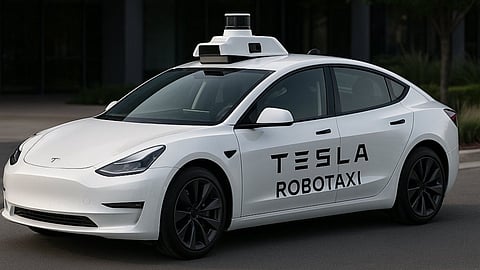
- LIFESTYLE
- FASHION
- FOOD
- ENTERTAINMENT
- EVENTS
- CULTURE
- VIDEOS
- WEB STORIES
- GALLERIES
- GADGETS
- CAR & BIKE
- SOCIETY
- TRAVEL
- NORTH EAST
- INDULGE CONNECT

Tesla has quietly launched its long-promised robotaxi service in Austin, Texas, marking a significant yet cautious step toward autonomous ride-hailing.
Each ride priced at a flat $4.20, according to Tesla CEO Elon Musk. The launch, which involved social media influencers showcasing their autonomous rides in videos reposted by Musk, comes amid heightened scrutiny over the safety and readiness of Tesla’s self-driving technology.
Unlike full-scale autonomous services, Tesla’s rollout comes with layers of human oversight. Each robotaxi includes a safety monitor seated in the front passenger seat, and the vehicles are also remotely monitored by humans using a system known as teleoperation.
Elon stated that the company is being "super paranoid about safety."
The approach reflects Tesla’s balancing act between innovation and caution, especially as it enters the high-stakes robotaxi race currently led by players like Waymo and Baidu.
What is teleoperation?
Teleoperation refers to the remote control of machines, in this case, vehicles, by humans located elsewhere, typically via wireless networks. Waymo, for instance, employs human “fleet response” agents to provide real-time assistance when its autonomous system encounters unfamiliar road situations.
In contrast, Baidu’s Apollo Go in China has used fully remote drivers who can take over vehicles in real time. Despite its utility, teleoperation comes with serious limitations.
Experts warn that reliance on cellular data connections for remote control can be risky due to potential lag, signal loss, or delay—issues that could prove dangerous during complex traffic scenarios.
Philip Koopman, a Carnegie Mellon engineering professor and autonomous vehicle safety expert, said: "Eventually, you will lose connection at exactly the worst time. If they’ve done their homework, this won’t ever happen for 10 cars. With a million cars, it’s going to happen every day."
Regulatory concerns in Texas Just days before the launch, a group of Democratic lawmakers from the Austin area urged Tesla to postpone the rollout until September, when a new autonomous driving law is set to take effect in Texas. They argued the delay would be in “the best interest of public safety and public trust.”
Despite their concerns, Tesla moved forward with the soft launch, limiting the service to areas considered safe for autonomous navigation and avoiding complex intersections.
Elon Musk has long championed the idea of fully autonomous Teslas, touting the company’s Full Self-Driving (Supervised) software as a step toward a future where driverless cars operate independently. Though the software is not yet fully autonomous, Musk has promised that an "unsupervised" version would power Tesla's robotaxis in the near future.
Tesla has even posted job listings for teleoperators, indicating that remote human intervention will remain a core part of its autonomy strategy, at least for now.
Tesla has not responded to media inquiries regarding the robotaxi launch or the specifics of its teleoperation system.
For more updates, join/follow our WhatsApp, Telegram and YouTube channels.